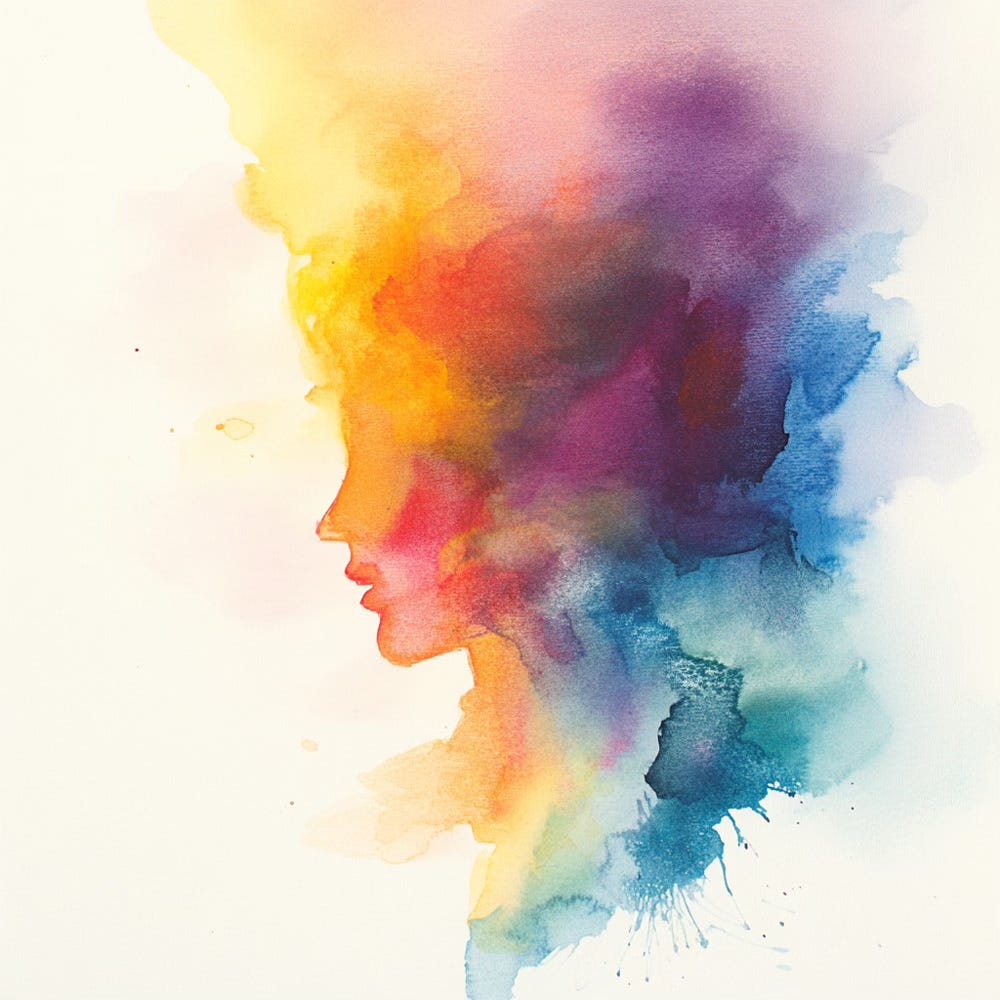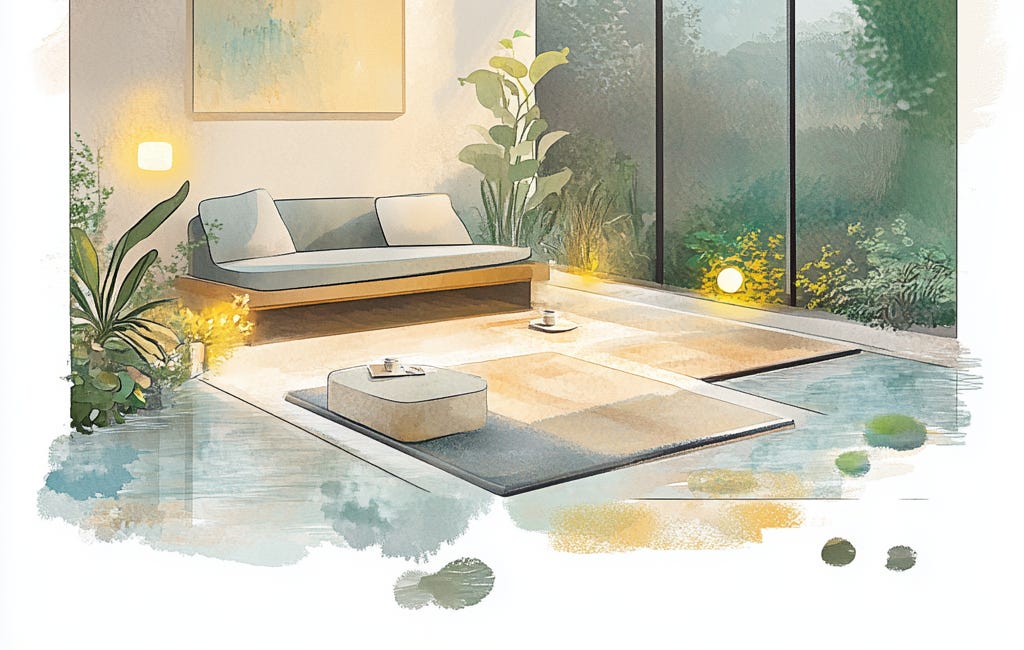I’ve always been fascinated by how our brains work—why certain things make us feel calm, inspired, or stressed.
Learning about neuroaesthetics has been another piece in the puzzle. It’s like discovering the secret language of design—how spaces “talk” to our brains without us even realising it.
Now, every time I walk into a room, I can’t help but analyse how it makes me feel.
Is the lighting too harsh? Are the colours jarring?
It’s become second nature. And yes, I’ve officially turned into my mum, who’s an interior designer.
On family holidays, she’d spend hours snapping photos, examining every corner, and commenting on the design. As a kid, I’d roll my eyes, mortified, but now? I’m the one analysing every detail—just in my own way.
I have become my mum. There’s no escaping it.
I just returned from a work trip where I had to power through a few urgent deadlines in my hotel room.
Let me tell you—it was nearly impossible to focus.
The lighting was terrible (I could even see it flickering—more on how that impacts health in the future), the room was dark, poorly designed, with a colour scheme that made no sense, and I couldn’t even open the window for fresh air.
Don’t even get me started on the rug—UGLY doesn’t even describe it!
But you know those moments when you just need silence to get work done? There were no cozy café vibes for me; I needed the quiet for deep spreadsheet work.
Luckily I was able to switch rooms later, but not before rearranging the furniture and stashing away half the ugly knickknacks that made no sense.
My mum does this all the time in hotels or even at other people’s houses—and now so do I!
The new room was a relief as it was far less horrifying than the last, but it really hammered home the power of design. A well-thought-out space can make or break your ability to focus, relax, and thrive.
Was this just me being picky? No—neuroaesthetics explains why.
What Is Neuroaesthetics?
Neuroaesthetics is the study of how aesthetics—like colour, shape, light, and texture—affect our brain and emotions. At its core, it combines neuroscience, psychology, and design to uncover why we respond to certain environments and how this impacts our mental and emotional states.
For example, why does a cluttered room feel stressful? Why do natural settings feel so calming? Neuroaesthetics reveals that:
Our brains are wired to seek harmony, balance, and beauty because they create a sense of safety and reward.
Having always been curious about how we’ve evolved and what motivates us, this felt like the missing puzzle piece.
My anthropology-loving brain went, “Aha! Of course this makes sense!”
My Kindle library has an entire neuroscience section—it’s basically a nerdy treasure trove.
The Science Behind Neuroaesthetics
When we encounter well-designed spaces, they trigger responses in key areas of the brain:
1. The Reward System:
Beautiful environments activate the brain’s reward center, releasing dopamine—the same neurotransmitter involved in pleasure and motivation.
This is why aesthetically pleasing spaces can make us feel happy, inspired, and energised.
Yes, your brain literally gives you a little “yay” in a beautiful room.
For someone who used to get dopamine hits from junk food, learning this was a revelation. Isn’t designing a beautiful space a much healthier way to get that same “feel-good” trigger?
No more late-night binges for me… or at least not very often.
2. The Prefrontal Cortex:
Responsible for focus and decision-making, this part of the brain is more engaged in harmonious environments, improving cognitive performance.
Chaotic or disorganised spaces, however, can overstimulate this area, leading to mental fatigue and stress.
3. The Amygdala:
This area regulates fear and stress responses.
Calming aesthetics—like soft lighting, natural textures, or balanced spaces—reduce amygdala activity, helping us feel relaxed and secure.
It’s incredible to think that something as simple as the way a space is designed can profoundly impact brain chemistry—and in turn, how we behave.
Key Design Elements and Their Effects
Here’s how specific design elements interact with your brain and emotions:
Natural Light
Exposure to sunlight triggers serotonin production, lifting mood and increasing energy.
Studies show that workplaces with natural light see a 15% increase in productivity and a 6% improvement in sleep quality.
(If I had to choose, I’d take a sunlit nook over fluorescent lighting any day.)
Try spending hours wandering around an old mall with fluorescent lighting—I guarantee you’ll feel drained by the end and not just because you spent the day shopping.
It is my worst nightmare—shopping, crowds, and terrible lighting. Shudder.
Colors
Warm tones (beige, peach, terracotta): Evoke feelings of comfort and intimacy.
Cool tones (blue, green): Promote focus, productivity, and calm.
Bright colors (yellow, red): Stimulate activity and attention but can cause overstimulation if overused.
What colors do you have in your home?
Shapes and Patterns
Organic shapes, like curves and circles, feel more soothing than sharp angles, which the brain associates with danger.
Fractals (repeating patterns found in nature) reduce stress by up to 60%, as shown in studies on biophilic design.
More on this in my post on biophilia here.
Textures and Materials
Natural materials, like wood or stone, create a grounding effect, connecting us to the earth.
Soft textures in furniture or fabrics provide tactile comfort, enhancing feelings of safety and warmth.
(I’ll admit it—I love fluffy, soft textures. Yes, it’s a “girl thing,” but come on—you can’t deny how comforting it feels!)
Symmetry and Balance
The brain is hardwired to find symmetry pleasing because it suggests order and predictability.
Spaces with balanced proportions are perceived as more harmonious, reducing mental effort and stress.
Visual Clarity
Research shows that environments with clear visual pathways, like open layouts, reduce cognitive load and help the brain process information more efficiently.
A Checklist for Your Space (Backed by Science)
Take a moment to assess your environment.
Is it supporting your brain or working against it?
Here are some science-backed factors to consider:
1. Lighting:
Is the lighting natural or full-spectrum? Poor lighting (especially flickering or fluorescent) increases mental fatigue and stress.
2. Colors:
Warm tones promote comfort, cool tones enhance focus, and bright tones energize—but too much can overstimulate the brain.
3. Air Quality:
Poor air circulation impacts concentration and even sleep. Can you open windows or add an air purifier?
4. Noise Levels:
Is the environment too noisy or too quiet? Background
5. Visual Organisation:
Is there clear visual clarity, or is the space cluttered?
6. Natural Elements:
Do you have plants, natural materials, or soft textures nearby?
How This Impacts Your Life?
I’m someone who thrives on being busy—running two businesses and juggling a million projects at once.
For me, creating spaces that reduce stress, support health, and boost productivity isn’t just a luxury; it’s essential.
Trust me, I’ve read all the books, listened to all the podcasts, and downloaded every app promising to improve productivity and cognitive performance.
But this? It’s another piece of the puzzle—and let’s be honest, isn’t it more fun than learning yet another “to-do” list methodology?
So much of the conversation about high performance focuses on routines, productivity hacks, or nutrition, but what about the spaces where we spend most of our time?
If your home or office is working against your brain, it’s time for a redesign.
I am not saying that everything else is not important - and it is - just this is another layer in the conversation that is often forgotten about.
Your environment shapes so much of who you are—your mood, productivity, and even your health.
Designing spaces that support your brain and emotions is one of the best investments you can make in yourself.
So, what small change will you make today?
As always, I’m so grateful you’re here. Please subscribe so you don’t miss anything in the future.
In future posts, I’ll share practical ways to apply these principles and how you can combine them with other concepts from Biophilia and Building Biology.
But for now, take a look around your space—what is it saying to your brain?
How to Bring Biophilic Design Into Your Home
Biophilic design isn’t just about aesthetics—it’s about how we’ve evolved to feel safe, secure, and inspired by nature.








Your insights on how our spaces speak to our souls are so powerful—love how you emphasize creating environments that spark joy and authenticity. The way you connect intentional design choices, like warm lighting and natural elements, to boosting mood and creativity is spot-on. I’m inspired by the idea of decluttering not just for aesthetics but to make room for emotional clarity and purpose. The questions you pose about aligning our spaces with our deepest values are such a great nudge to rethink my own home. Thank you for this beautifully written, thought-provoking piece—it’s a reminder of how much our surroundings shape our energy and growth!